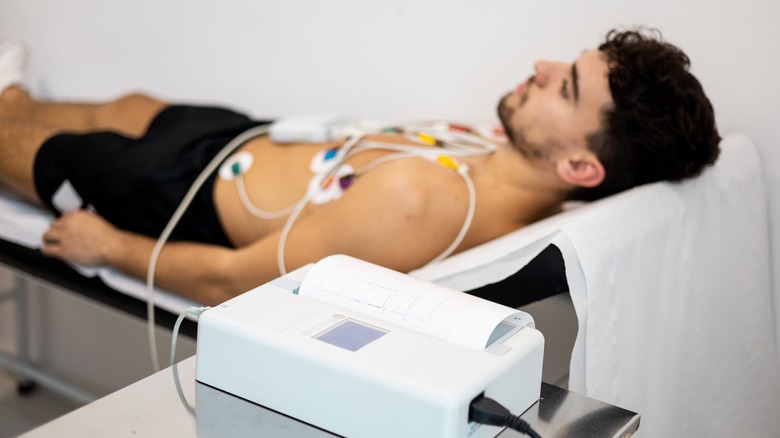Medical Conditions That Increase Your Risk Of Sudden Adult Death Syndrome
Young adults with no previous health problems could suddenly experience cardiac arrest without any previous symptoms or warning. Cardiac arrest differs from a heart attack in that cardiac arrest occurs due to a problem with your heart's electrical system rather than a blockage. Although sudden adult death syndrome (SADS) is rare, Tampa Cardio says cases are on the rise. SADS occurs when a heart abnormality causes the heart to beat irregularly, known as an arrhythmia.
What causes SADS has stumped medical researchers, but some cases could be linked to specific genes. Men and people from Southeast Asia are more likely to have SADS. Although you could have SADS without any other health issues, you could be more at risk for SADS if you have heart disease, a known arrhythmia, or hypertrophic cardiomyopathy. Bipolar disorder and schizophrenia might also increase your risk of SADS, and SADS could also occur after an epileptic seizure.
What's tough about sudden adult death syndrome is that it isn't diagnosed until the person has died. According to the SADS Foundation, some SADS deaths due to arrhythmia could be prevented if you're aware of some of the warning signs and medical conditions that affect your risk.
Some warning signs and conditions that can lead to SADS
The SADS Foundation said one warning sign of SADS is whether you've had a family member who died under the age of 40 from an unexplained death. Young people who faint or have seizures during exercise or excitement might also point to a condition linked to SADS. People at risk for SADS might also feel chest pain or shortness of breath while exercising.
Long QT Syndrome (LQTS) is one of the conditions that could lead to SADS. The SADS Foundation believes that one out of 2,000 people in the United States could have LQTS, but almost half don't have symptoms. LQTS might account for up to 12% of sudden infant death syndrome (SIDS) cases. According to a 2011 article in The Lancet, people with epilepsy are 20 times more likely to die from a sudden death than other people, especially if they have more frequent tonic-clonic seizures.
Cardiac arrest can occur more than twice as often in people with bipolar disorder and four times more often in people with schizophrenia, per a 2021 study in Heart. The risk was also apparent, whether people had a history of heart disease or not. Taking antipsychotics for their conditions increased the risk of cardiac arrest. A 2019 article in Psychiatry Research said that antipsychotics increase the risk of sudden cardiac death because they block some of the ion channels that regulate the heart's rhythm.
Treating people at risk for SADS
Even though fainting, heart rhythm issues, and family history can be common signs of sudden death, a 2014 article in Circulation: Arrhythmia and Electrophysiology found that 90% of the sudden deaths didn't have these warning signs. Less than 7% of the hearts showed abnormalities, especially in people older than 35 years old. However, the heart abnormalities weren't linked to their deaths.
If you do have signs of a SADS condition like LQTS, a doctor will order a series of electrocardiograms (ECG), a treadmill stress test, and a remote ECG to determine a diagnosis. Treatment typically involves taking beta-blockers, but surgery or an implanted device might also be needed.
People taking antipsychotics to treat their mental health conditions like schizophrenia or bipolar disorder might turn to healthcare wearable devices to protect them from sudden cardiac death. The 2019 study in Psychiatry Research suggested that new wearable devices have ECG monitors that can detect arrhythmias. Data about your ECG and heart rate can be sent to your doctor to detect a possible risk of cardiac death.
A 2018 article in Aging said that monitoring heart rate variability might also be useful in the future in detecting the risk of cardiac death. Heart rate variability measures the intervals between heartbeats, and a low heart rate variability indicates poorer health. Wearable devices can also track heart rate variability, but more research is needed on how they can reliably predict the risk of death.



